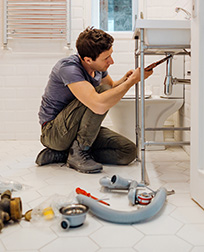Trusted Plumbing Services Alabaster AL for All Your Repair works
Trusted Plumbing Services Alabaster AL for All Your Repair works
Blog Article
A Detailed Guide to Efficient Water Heater Installation for Optimal Performance
Beginning on the job of installing a water heating unit is an endeavor that demands accuracy and an organized method for attaining optimal performance. As you continue, the intricacies of linking water supply lines and establishing up reputable electric or gas links await, appealing understandings into making sure performance and reliability.
Selecting the Right Water Heating System

Following, consider the size and ability of the water heating system. It's important to analyze your household's warm water requirements, which can differ based on the number of passengers and their use patterns. A device that's also small may result in inadequate warm water, while an extra-large version could cause unneeded power consumption.
Effectiveness scores likewise play an essential function in option. Seek water heaters with high Energy Factor (EF) scores, suggesting remarkable efficiency and minimized power use. Tankless versions, though usually a lot more costly in advance, offer considerable power financial savings gradually as a result of their on-demand home heating capacities.
Preparing the Installation Location
Before setting up a brand-new water heater, careful preparation of the installation location is vital. It's essential to gauge the space meticulously to accommodate the water heating system's dimensions, making sure adequate clearance around the system for efficient operation and maintenance.
Next, eliminate any kind of particles, dust, or obstructions from the site to develop a tidy environment. Inspect the flooring for security, as the hot water heater will require a strong, level surface to run properly. If required, mount a drip pan underneath the device to catch possible leaks or spills, avoiding water damages to the surrounding area. In areas susceptible to seismic activity, think about mounting seismic straps to protect the heating unit strongly in position.
Furthermore, make certain that all necessary tools and materials are on hand before beginning the installment. This consists of things such as wrenches, screwdrivers, a degree, and any additional equipment required for placing and safeguarding the heating system. A well-prepared installation location establishes the foundation for a successful hot water heater arrangement, enhancing performance and safety.
Connecting Water Supply Lines
When attaching water system lines to your recently installed hot water heater, it is critical to make certain that all links are leak-free and safe to preserve efficient procedure and avoid water damage. Begin by recognizing the hot and cool water system lines. The chilly water inlet is generally noted with a blue tag or a "C", while the warm water read electrical outlet is marked with a red tag or an "H".
Use flexible water heating system adapters to assist in an easier installment process. Before affixing the connectors, place a plumbing technician's tape around the threaded ends of the water heating system's inlet and electrical outlet pipelines.
As soon as connections remain in area, gradually switch on the primary water system shutoff. Evaluate each connection for leaks by visually feeling and checking for wetness. Tighten connections as required, and make sure the stress safety valve is appropriately mounted, guarding against excessive pressure build-up.
Establishing Electrical or Gas Connections
Appropriately establishing up the electric or gas connections for your water heating unit is an essential step to guarantee risk-free and efficient procedure. For electrical hot water heater, begin by confirming that the electric circuit is suitable with the heating unit's voltage and amperage needs. Ensure the power supply is switched off at the breaker to stop accidents. Connect the electrical cables to the heating system adhering to the manufacturer's electrical wiring representation. Commonly, this entails attaching the ground wire to the green terminal, and the remaining wires to their equivalent terminals, safeguarding each with cable nuts.
For gas water heating systems, safety is extremely important. Connect the gas line to the water heating unit using a versatile gas connector, guaranteeing it is properly threaded and secured with pipe joint compound or Teflon tape suitable for gas connections.
As soon as connections are made, evaluate for any possible leaks. For gas lines, apply a soapy water remedy check my blog to the joints; bubbles indicate a leakage. For electrical connections, double-check that all electrical wiring is protected and correctly shielded, preserving compliance with neighborhood electrical codes.
Testing and Changing for Efficiency
With the electric and gas connections securely in location, the following action is reviewing the operational performance of your water heating unit. Begin by very carefully turning on the water supply and guaranteeing there are no leaks at any of the joints or valves.
Next, carry out a detailed examination to make certain the burner or burner are operating properly. For electric heating systems, use a multimeter to confirm if the elements are attracting the proper present. In gas models, observe the heater fire; it should be blue and steady, showing effective burning.
Change the setups as essential to remove inadequacies. Take into consideration carrying out insulation steps, such as adding a water heating unit blanket, to better improve performance by minimizing warmth loss. Additionally, check the anode pole's condition, as a scrubby rod can lower efficiency and bring about container rust.
Conclusion
Efficient water heating unit setup is vital for ensuring optimal performance and power financial savings. Securely linking water supply lines and very carefully setting up electrical or gas connections decrease possible concerns.

Properly setting up the electrical or gas links for your water heating system is a critical action to make sure effective and secure procedure. For electric water heating units, start by validating that the electrical circuit is compatible with the heating unit's voltage and amperage demands. Link the gas line to the water heating system using a flexible gas connector, ensuring it is appropriately threaded and secured with pipeline joint substance or Teflon tape ideal for gas connections.
Report this page